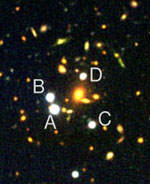
Image credit: SDSS
Gravitational lensing happens when the light from a distant object, such as a quasar, is distorted by the gravity of a closer object. Astronomers have discovered just such a lens, where the distortions are so great, they have to be caused by a significant amount of dark matter – the visible material alone couldn’t be responsible. Dark matter is predicted by its gravitational influence on galaxies and stars in the Universe, but so far, astronomers aren’t really sure what it is; whether it’s just regular matter which is too cold to be seen from Earth, or some kind of exotic particle.
Sloan Digital Sky Survey scientists have discovered a gravitationally lensed quasar with the largest separation ever recorded, and, contrary to expectations, found that four of the most distant, most luminous quasars known are not gravitationally lensed.
Albert Einstein’s Theory of General Relativity predicts that the gravitational pull of a massive body can act as a lens, bending and distorting the light of a distant object. A massive structure somewhere between a distant quasar and Earth can “lens” the light of a quasar, making the image substantially brighter and producing several images of one object.
In a paper published in the December 18/25 edition of NATURE magazine, a Sloan Digital Sky Survey (SDSS) team led by University of Tokyo graduate students Naohisa Inada and Masamune Oguri report that four quasars in close proximity are, in fact, the light from one quasar split into four images by gravitational lensing.
More than 80 gravitationally lensed quasars have been discovered since the first example was found in 1979. A dozen of the cataloged lensed quasars are SDSS discoveries, of which half are the result of the work of Inada and his team.
But what makes this latest finding so dramatic is that the separation between the four images is twice as large as that of any previously known gravitationally lensed quasar. Until the discovery of this quadruple lens quasar, the largest separation known in a gravitationally lensed quasar was 7 arcseconds. The quasar found by the SDSS team lies in the constellation Leo Minor; it consists of four images separated by 14.62 arcseconds.
In order to produce such a large separation, the concentration of matter giving rise to the lensing has to be particularly high. There is a cluster of galaxies in the foreground of this gravitational lens; the dark matter associated with the cluster must be responsible for the unprecedented large separation.
“Additional observations obtained at the Subaru 8.2 meter telescope and Keck telescope confirmed that this system is indeed a gravitational lens,” explains Inada. “Quasars split this much by gravitational lensing are predicted to be very rare, and thus can only be discovered in very large surveys like the SDSS.”
Oguri added: “Discovering one such wide gravitational lens out of over 30,000 SDSS quasars surveyed to date is perfectly consistent with theoretical expectations of models in which the universe is dominated by cold dark matter. This offers additional strong evidence for such models.” (Cold dark matter, unlike hot dark matter, forms tight clumps, the kind that causes this kind of gravitational lens.)
“The gravitational lens we have discovered will provide an ideal laboratory to explore the relation between visible objects and invisible dark matter in the universe,” Oguri explained.
In a second paper to be published in the Astronomical Journal in March 2004, a team led by Gordon Richards of Princeton University used the high resolution of the Hubble Space Telescope to examine four of the most distant known quasars discovered by SDSS for signs of gravitational lensing.
Looking to great distances in astronomy is looking back in time. These quasars are seen at a time when the universe was less than 10percent of its present age. These quasars are tremendously luminous, and are thought to be powered by enormous black holes with masses several billion times that of the Sun. The researchers said it is a real mystery how such massive black holes could have formed so early in the universe. Yet if these objects are gravitationally lensed, SDSS researchers would infer substantially smaller luminosities and therefore black hole masses, making it easier to explain their formation.
“The more distant a quasar, the more likely a galaxy lies between it and the viewer. This is why we expected the most distant quasars to be lensed,” explained SDSS researcher Xiaohui Fan of the University of Arizona. However, contrary to expectations, none of the four shows any sign of multiple images that is the hallmark of lensing.
“Only a small fraction of quasars are gravitationally lensed. However, quasars this bright are very rare in the distant universe. Since lensing causes quasars to appear brighter and therefore easier to detect, we expected that our distant quasars were the ones most likely to be lensed,” suggested team member Zoltan Haiman of Columbia University.
“The fact that these quasars are not lensed says that astronomers have to take seriously the idea that quasars a few billion times the mass of the Sun formed less than a billion years after the Big Bang”, said Richards. “We’re now looking for more examples of high-redshift quasars in the SDSS to give theorists even more supermassive black holes to explain.”
Original Source: SDSS News Release
